A “Bug Out Bag” is something you would prepare for an emergency when you need to leave your home.
This could be due to a forest fire, tornado, gas leaks in the neighborhood, etc. Think of floods in the area, or other unexpected emergencies.
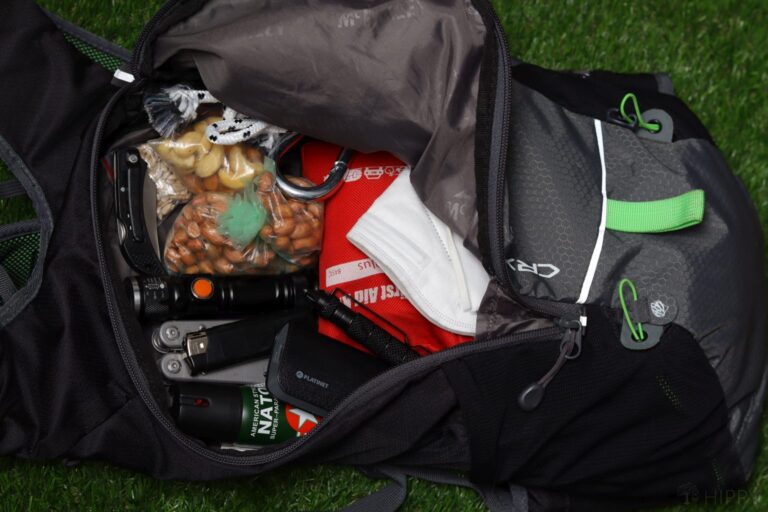
There will be times you will have to leave and not return for up to 72 hours, and to minimize the stress of that, here are the top items to have in a bug out bag.
Change of Clothes for Each Family Member
This needs to be checked on seasonally, and make sure that you have clothes that fit.
There’s nothing worse than having to leave home during the heat of the summer only to find you have only wool sweaters that are 2 sizes too small.
I usually grab an extra set of clothing for my kids at the thrift store for this purpose. They don’t have to be pretty, just fit and be comfortable.
You will want to include at least a change of good socks as well. My hubby and oldest son swear by wool socks, even in the summer, for keeping feet cool and dry.
Spare Socks and Underwear
Taking care of your feet is vital when you must walk on them all day.
If a long trek to safety is required, excavating out of your destroyed neighborhood or just standing up and pulling guard duty, allowing your feet to get beaten up for any reason will quickly result in you being immobilized.
It’s easy for your feet get dirty and wet while walking or working, so bring extra socks and change them on a regular basis.
Underwear is also crucial: when you walk or work, your groin region and backside get no light, lots of moisture, and a lot of friction.
It’s common for skin problems and germs to develop in such a situation. To assist you in staying dry and conformable, change your underwear on a regular basis!
Rain Poncho
When the weather turns wet, a durable poncho will easily keep you warm, dry and much happier.
It’s also a wonderful ground cover in nasty conditions to prevent your clothes from getting damp or dirty.
These may still be folded up and stored away in most circumstances. You might also want to bring two for double the insulation and water resistance. Select your size depending on how much clothing you plan on wearing outdoors.
Space Blanket
Ultra-modern metallic blankets aren’t just the stuff of sci-fi adventure shows; these things have the name for a reason!
First developed for NASA astronauts as a way to keep warm while adding almost nothing to a shuttle’s payload, these ingenious blankets can do the same for you and your family.
Camping out in the open or sleeping in a shelter, these also act as reflectors for your campfire and can be used as a signaling device.
They compress down to such tiny sizes and weigh practically nothing, making them an auto-include for any BOB as far as I am concerned.
You might end up looking like takeout, but you’ll be warm thanks to these things.
First-Aid Kit
During or after a disaster, you should anticipate injuries occurring. These wounds can be minor and annoying, or serious and deadly. You won’t know until it happens but assume that it will!
To ensure your survival, you’ll need the tools, supplies, and abilities to deal with a broad range of injuries.
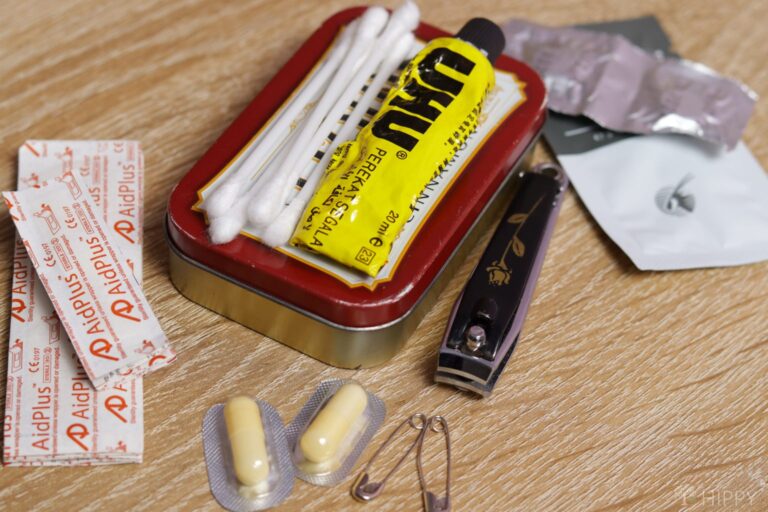
Supplies should therefore be in two modules within your kit- one for small problems and one for really bad injuries.
Your minor kit has band-aids, antiseptics, tiny gauze pads, pain relievers for common aches and pains, any prescription medicines you’ll need, and blister and burn relief items.
Medical tape, pressure dressings, chest seals, hemostatic gauze strips/pads, slings, splints , and serious painkillers should all be in your major kit.
Don’t expect that you’ll figure things out or rise to the occasion when someone gets hurt: Get training! Otherwise you’ll be watching yourself or someone else expire in a crisis.
Sun Protection
After you bug out, you’ll undoubtedly be exposed to more sun than usual.
To keep your body protected from the sun’s intense rays, pack seasonally appropriate clothing. In winter or cold climates, you may use your regular attire supplemented with cold-weather outer layers.
You’ll need to be a little smarter in hotter or dry regions, where wearing light technical textiles that won’t overheat you but will still keep you covered is a smart choice. Sunscreen should also be considered in both hot and cold climates, despite its lack of popularity.
Severe sunburn is a nasty injury you cannot afford in an emergency situation, so don’t risk it when you are already in a bind.
Bandanas / Neckerchief
A bandana is a must-have item for every BOB.
This basic piece of cloth may be used as a simple first-aid bandage, head covering, insulating layer, placemat, rag, sweatband, lashing, signaling device, pouch, water filtering device, and more.
These are just too useful to ignore. Pack at least two; you’ll discover numerous uses for them when you are in the field.
Cash
Carrying debit cards is convenient, but in an emergency situation, you want to make sure there is some cash at your disposal.
I often recommend $100 minimum, in small denominations. I also would include at least a roll of quarters, for doing laundry as needed.
This will just make life easier, if you are leaving home due to a major power outage in your neighborhood, as the card readers will not be working.
Toothbrush and Toothpaste
Being able to brush your teeth, even if you haven’t been able to shower in 2 days is almost magical in lifting your spirits.
When you check your clothing, check to make sure that the toothbrushes are in good condition.
They are around $1 for a six-pack of toothbrushes in our area (cheap ones) and that is really all you need…so keep them new as much as possible.
Wet Wipes
Being tidy and clean is critical for good health and the prevention of infection. You should be making time to clean yourself up even during or after a major catastrophe.
If water is unavailable or highly restricted, you should keep a large pack of wet wipes in your kit. A handful will allow you to clean up similarly to how you would with a sponge bath.
Taking care of your body isn’t just for smelling nice; the need to remove dirt and germs to prevent disease should be obvious!
To ease the bathing procedure, consider purchasing the large-size, heavy-duty wet wipes instead of the small, flushable size.
Books and Cards
This isn’t the time to carry tons of books, but having a Bible (or other religious book) and a deck of cards will provide some entertainment and comfort during an emergency situation. I like to have at least one small paperback for each child as well.
They all have Kindles, but what if they aren’t charged for some reason? A magazine or two are also lightweight to carry and will keep kids’ minds off not being at home.
Snacks and Easy to Prepare Foods
When you visit a link in this article that takes you to a different website where you can purchase something, I may earn a commission. Read my full disclosure for more details.
Having some quick and easy meals on hand, that require little to no preparation will make this short time easier to handle. I usually have granola bars, a couple of jars of home-canned chili, and crackers.
This isn’t “real food” per se, but it’ll keep you fed during this short period of time. If you can afford (and stomach it) MREs can be a viable option as well.
Drinking Water
Having some drinking water, at least 2 quarts per person per day is important. Especially if you are camping out during this time.
I don’t like plastic at all, and glass jars get really heavy to carry, so I like to grab a stainless steel tumbler and fill it quickly before we leave.
Of course, there will be times when you can’t get clean water during a short emergency, so one personal water filter (such as a Lifestraw or a Sawyer Mini) per person is a good investment as well.
Bush Knife
A big, robust fixed-blade knife is your one true partner in the field, even if it’s only around town.
After a disaster, a bush knife may be used to chop and process wood, scrape, pry, skin, and self-defense. Make sure you have decent protection for it as well.
A bush knife can be converted into a spear by lashing it to a sturdy branch, giving you more distance when defending yourself without having access to a gun and additional standoff when hunting large game if you don’t have one.
Multi-Tool
A multi-tool is the partner of your bush knife, capable of performing tasks that it cannot or just doesn’t do well.
You may not think you need it, but your gear, automobile, and structures have hundreds of fasteners that must be turned and tightened, using any number of handy tools.
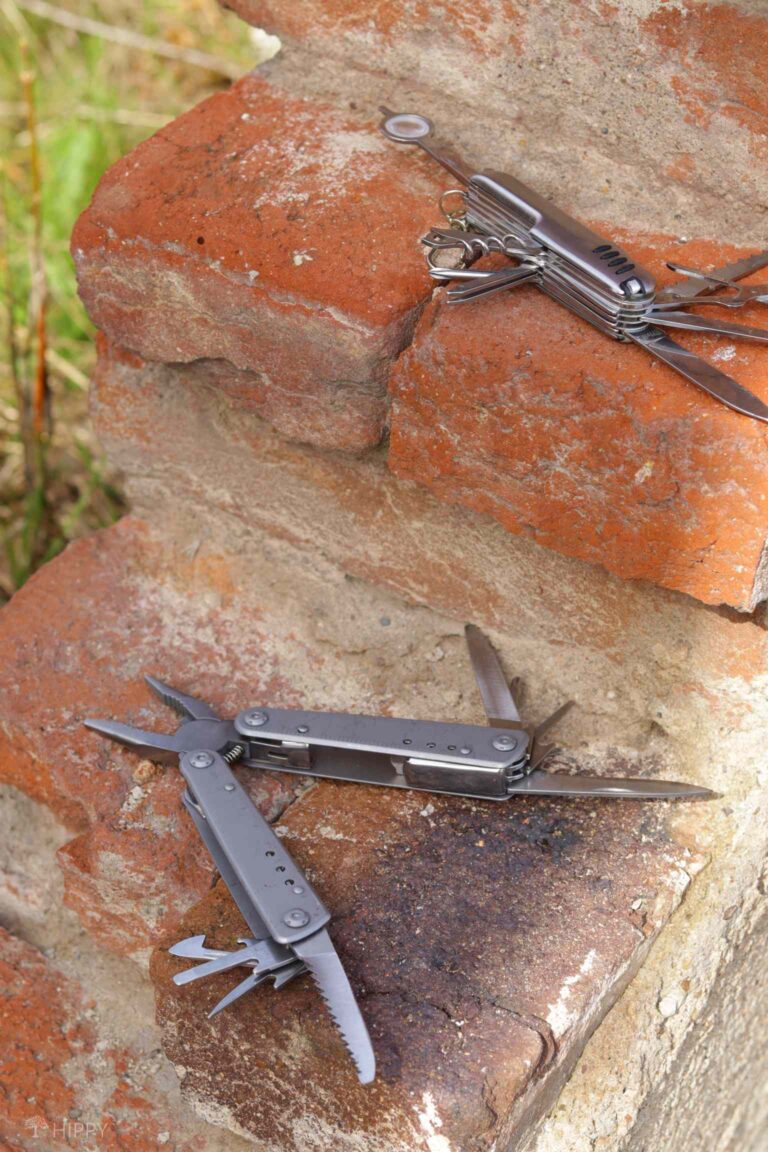
Containing everything from tiny saws to magnifying glasses, small detail knives to pliers, a decent multi tool will handle it all.
A smaller model such as a Swiss army knife, or a classic Leatherman, SOG or Gerber could be an alternative.
If you want to take a smaller tool and some dedicated vise-grips with you that is fine, too.
Flashlight / Headlamp
Bad things can happen in the dark. You don’t want to get caught out in the dark without anything to light your way, especially if you’re vulnerable already.
Even a simple activity like putting up your tent will be far more difficult with no source of light to work by.
A good, bright flashlight or, even better, a headlamp that allows you to work hands-free will illuminate the night at the press of a button.
Variable brightness settings, color choices for preserving low-light vision, and even distinct blinking signal or SOS modes will be available on nicer models.
As long as the batteries endure, working or navigating in the dark will be simple. Don’t forget about packing the backup batteries you’ll need!
Campsite Tools
A hatchet, folding shovel, and a hammer will make life so much easier if you have to walk through woods or make a fire at a campsite.
We bought these at a garage sale and cleaned them up and they are packed in my hubby’s backpack.
We also have an extra set in the van for emergency times on the road. You just never know when you will need a shovel, really.
Trust me, some matches are also a good idea. I carry some waterproofed matches in an old medicine container to keep them clean and dry.
Tinder
Even with a lighter or matches, starting a fire using found fuel may not be as simple as you think.
When you want to have a fire going right away, use a small amount of pre-made tinder to get it burning quickly.
This tinder might be anything from store-bought accelerant bricks or Vasoline-soaked cotton balls to char cloth or tiny fragments of rubber inner tube. Some folks just use dryer lint!
Everyone has their own favorite for their own reasons but all of the above will light up readily and burn fiercely when you need a fire going ASAP.
Compass
A compass may come in handy wherever you go. A compass will provide fundamental direction-finding information, allowing you to get from Point A to Point B or at least not head in the wrong direction.
Of course, a good map and the ability to use both are required for overland navigation with true accuracy, but if all you take is the bare minimum, make it a compass.
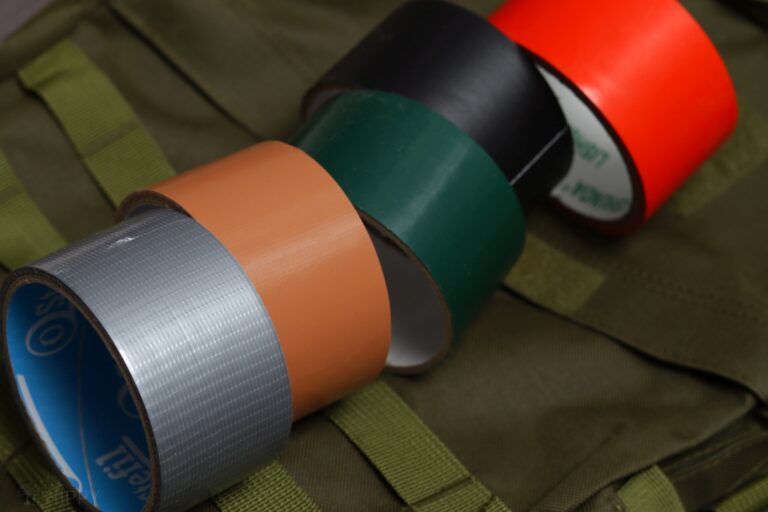
Duct Tape
Naturally! It’s a given that you’ll want to bring duct tape with you. From repairs and lashings to quick medical care, duct tape does it all.
You may save more room in your bag by wrapping a bottle or bowl around it. Not all brands are made equal; try out several and see which has the best combination of tear resistance, adhesion, and shear strength for your needs.
I like Gorilla Tape and T-Rex Tape not because of their amusing names, but really due to their super-tough fabric backing. You should be able to fix or improvise whatever you need with good duct tape.
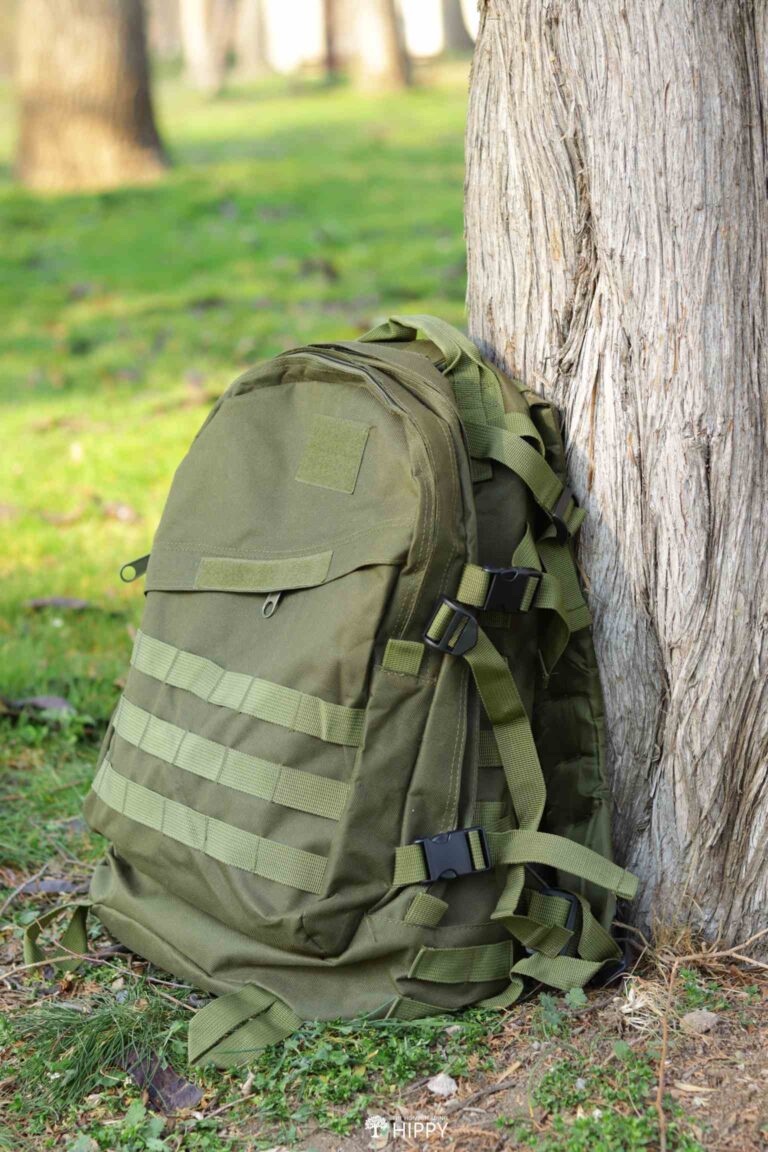
Pack
Having these things in a sturdy backpack that each member can carry on their own is important. For smaller children, their packs can contain a Lifestraw, snacks, and maybe a favorite toy and book.
Our children are all old enough to carry what’s in their pack by themselves, but we do make sure they aren’t overloaded.
Sometimes, you have to let go of some things you think you need but really don’t. How do you know?
Practice
Once a season, we will “bug out” with our kids and figure out what needs to go into the packs and what should’ve stayed behind.
Sometimes we will stay out for a full 72 hours, sometimes, we just go in the afternoons.
It keeps things interesting as the kids never know when we will have to bug out, and if they forgot something, it’s remembered the next time! What would you add to a bug-out bag for 72 hours?

Heather’s homesteading journey started in 2006, with baby steps: first, she got a few raised beds, some chickens, and rabbits. Over the years, she amassed a wealth of homesteading knowledge, knowledge that you can find in the articles of this blog.
Learn more about Heather and the rest of the writers on this page.

I was just thinking the other day that I needed to have something like this in case we have to evacuate due to a forest fire!
Thanks for posting. Always a good idea to be ready
These are great things to have in your bag. I try to keep a change of clothes for the girls and myself in the car because you never know when we might need it while we are out.
Cash is a good one to note! In a day where it’s becoming a lot less common to carry it, there are times I’ve come across where I sure wished I had a couple of dollars on me (esp. in a hot amusement park w/a water machine that only took cash). 😉
We have a Life Straw too! It’s such a cool invention.
A small first aid kit! Or at least some hand sanitizer or wipes and a few band-aids.
What an AWESOME idea!!! I do not have a Bug Out Bag.. but I so need to make one 🙂 Love this… pinning as we speak!
I’ve never heard it called that, just a 72-hour kit or something like that. What a fun name!
For kids I get cheap or free coloring activity books and cheap or free crayons (Smokey the
Bear and the firefighters usually give them away) and a scratch pad for playing Hangman or other pencil and paper games. Besides a regular deck of cards, I have a deck of Uno cards, always good, especially for multiple ages.
First Aid kit, prescription meds, extra glasses, plus things for infants, disabled or elderly family members, and your pet.